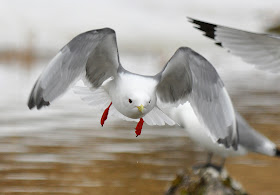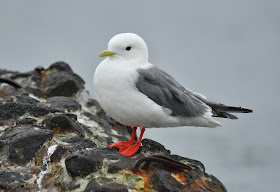 |
| Two birders view the nesting alcids on the cliffs of St. Paul Island, Alaska. (This and all photos in this post are copyrighted by the author, Ryan O'Donnell.) |
This summer I had the great pleasure of working as a guide on St. Paul Island, Alaska. This 14-mile long island in the middle of the Bering Sea is a mecca for birders looking for rare birds from Asia, especially birders who keep a North American or American Birding Association Area list. But this island also draws birders from around the world for its unique collection of regularly breeding birds.
Most of the birds that breed on the island use cliffs, like the ones shown above, for breeding sites. Some of these are widespread species, like Common Murres and Thick-billed Murres. Many of the smaller alcids here are unique to the Bering Sea region, like Parakeet Auklets, Least Auklets, and Crested Auklets. Another big draw, especially for photographers, is the puffins: both Horned Puffins and Tufted Puffins nest on the island.
 |
| A Common Murre on the cliffs of St. Paul Island. Despite the name, Common Murres are somewhat less common than Thick-billed Murres here, although they are still easily seen throughout the breeding season. |
 |
| Thick-billed Murres are the more common of the two murre species breeding on St. Paul Island. One way to distinguish them is by the bright white gape line, which is lacking in Common Murres. |
 |
| Two Thick-billed Murres attend their single egg. Murres don't build nests; they lay their single egg directly on a small little ledge on a cliff. |
 |
| A pair of Parakeet Auklets on a cliff. The clump of vegetation under the bird on the right looks like a nest, but it is not. This species nests in cracks and crevices in the cliff wall. |
 |
| Another Parakeet Auklet, this time framed by some of the Nootka Lupine that is abundant on the island. |
 |
| One of the cutest birds in the world, a Least Auklet. This species usually nests among piles of boulders at the base of cliffs or other areas, but sometimes also nests among the cracks in the cliff. |
 |
| The distinctive Crested Auklet, probably the least abundant of the nesting alcids on St. Paul Island, but still easily found on almost any day in the breeding season. |
 |
| A Tufted Puffin lands at the cliffs with some nesting material. Both species of puffins on the island nest in burrows in or around the cliffs. |
 |
| Another Tufted Puffin, among the most charismatic of the birds on the island. |
 |
| A Horned Puffin in flight past the cliffs. People often wonder why they are called "horned" until they get close enough to see the small black lines above the eyes are actually little fleshy horns that stick up above the head. |
 |
| A pair of Horned Puffins at the entrance to their nesting burrow near the top of one of the cliffs. |
Two other unique groups of birds use the cliffs for nesting, the cormorants and the kittiwakes. Cormorants include the relatively widespread Pelagic Cormorant, and also the Bering Sea endemic Red-faced Cormorant. Both species have some red on their faces, so the best way to tell them apart, even at a distance, is by the pale bill and relatively thicker head and neck of the Red-faced Cormorant.
 |
| The two breeding cormorant species on St. Paul, a Red-faced Cormorant at left and a Pelagic Cormorant at right. |
 |
| Red-faced Cormorant, endemic to the Bering Sea area. |
Finally, we have two species of kittiwakes that nest on St. Paul. Black-legged Kittiwakes are by far the most abundant. They are a circumboreal species, found around the northern oceans. Red-legged Kittiwakes, in contrast, nest in only four areas around the Bering Sea. They are high on the wish list of many birders that visit the island. Black-legged Kittiwakes outnumber Red-legged on St. Paul by maybe 10 or 20 to one, but Red-leggeds can still be seen easily on any day in the breeding season.
 |
| A Black-legged Kittiwake adult and nestling. |
 |
| Large flocks of Black-legged Kittiwakes can be seen around the island, particularly at many of the small freshwater lakes like this one, appropriately called "Kittiwake Lake" where the kittiwakes gather to bathe. |
 |
| Two Red-legged Kittiwake nests. Red-legged Kittiwakes generally prefer higher breeding sites among the cliffs, so on St. Paul you usually have to hike to the highest cliffs, about 400 ft. above sea level, to see their nests. |
 |
| A Red-legged Kittiwake in flight. When the red legs dangle, they are easy to identify, but Red-legged and Black-legged Kittiwakes can still be identified in flight when their legs are tucked up into their feathers. |
 |
| One of the coolest gulls in the world, in my opinion: a striking Red-legged Kittiwake. |
Coming soon: a post on the other breeding birds of St. Paul Island, those that breed away from the cliffs.




















No comments:
Post a Comment